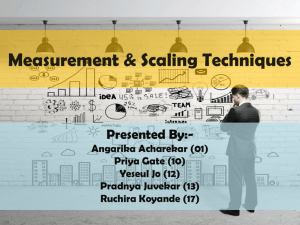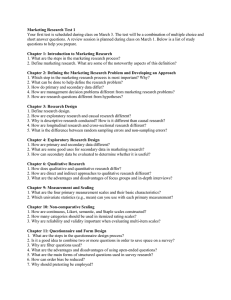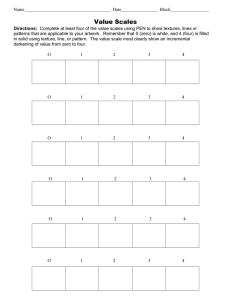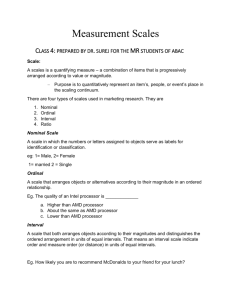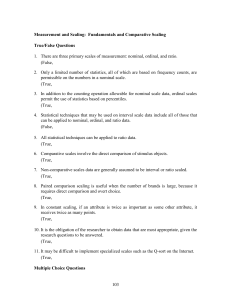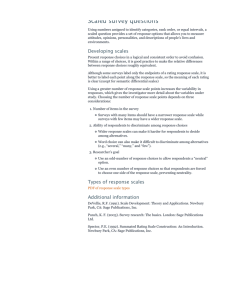Marketing Research Designs: Descriptive & Causal
advertisement
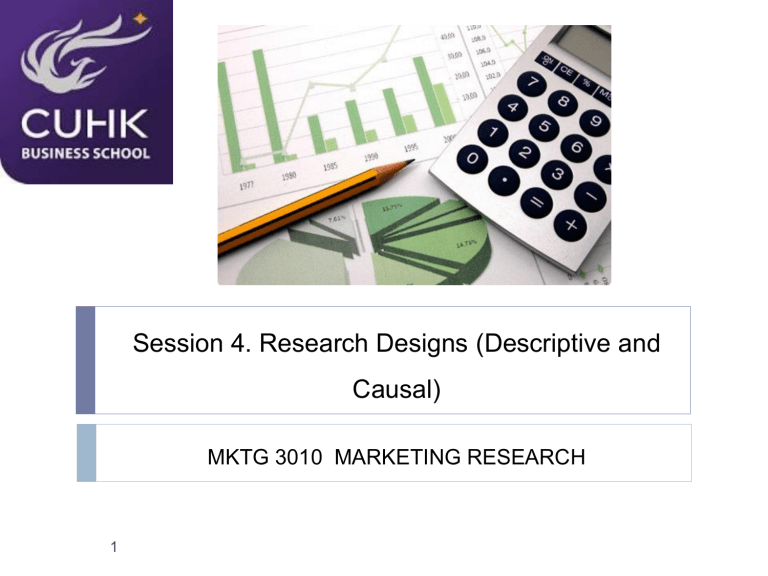
Session 4. Research Designs (Descriptive and Causal) MKTG 3010 MARKETING RESEARCH 1 Exercises - An Unusually Crowded Summer Box Office, in Charts 2 Provide a description of Figure 1? What’s the difference between Figure 1 and Figure 2? Why we create Figure 2? What is “endogeneity”? What is the “endogeneity” problem in this context? What are the explanations for the crowded summer box office? Which one is more plausible? Why? Shall we release the new movie in summer? Figure 1 3 Figure 2 Endogeneity More People Watch Movies 4 More Movies Released Marketing Research Process Step 1: Defining the Problem Step 2: Developing an Approach to the Problem Step 3: Formulating a Research Design Step 4: Doing Field Work or Collecting Data Step 5: Preparing and Analyzing Data Step 6: Preparing and Presenting the Report 5 Definition A research design is a framework or blueprint for conducting the marketing research project. It details the procedures necessary for obtaining the information needed to structure or solve marketing research problems. 6 A Comparison of Basic Research Designs Exploratory Descriptive Causal Objective: Discovery of ideas and insights Describe market characteristics or functions Determine cause and effect relationships Characteristics: Flexible, versatile Methods: 7 Marked by the prior Manipulation of formulation of specific independent hypotheses variables, effect on dependent Often the front end Preplanned and variables of total research structured design design Control mediating Expert surveys Secondary data: variables Pilot surveys quantitative analysis Focus group Surveys Experiments Secondary data: Panels qualitative analysis Observation and other qualitative research data Descriptive Research 1.Survey 8 Methods of collecting descriptive data Two ways to obtain quantitative descriptive data SURVEY Information Obtained by Questioning Respondents 9 OBSERVATION Information Obtained by Observing Behavior/ Phenomena Classification of survey methods Survey Methods Telephone Traditional Telephone ComputerAssisted Telephone Interviewing 10 Personal Mail Electronic In-Home Mail Panel E-Mail Mall Intercept Mail/Fax Interview Internet ComputerAssisted Personal Interviewing South Korean Soap Operas: Just Lowbrow Fun? (WSJ, Jul 23, 2013) Researcher: Seoul National University Research Method: Survey Sample: 400 people aged between 20 – 60 in China in January Approach: divided viewers’ tastes into categories according to the levels of income and education. Findings: 1. the main audience for South Korean series tends to be less educated and have less income than viewers that prefer programs from other countries. 2. The high-education-and-high-income group showed a preference for the subject matter’s novelty, fast pace and suspense — often found in U.S. TV shows, the report said. 3. “The Big Bang Theory” was the most popular feature for fans of American TV. Implication: What is it about South Korean TV soap operas that appeals to foreign audiences? it’s because it’s lowbrow entertainment. The report also offers a caveat: highly-educated and high-income viewers may conceal their fondness of lowbrow entertainment. (http://blogs.wsj.com/korearealtime/2013/07/23/south-korean-soap-operas-just11 lowbrow-fun-2/) Advantage of survey research Ease: Questionnaires are relatively easy to administer. Reliability: Using fixed-response (multiple-choice) questions reduces variability in the results that may be caused by differences in interviewers and enhances reliability of the responses. Simplicity: It also simplifies coding, analysis, and interpretation of data. reliability: the measure produces similar results under consistent conditions 12 Disadvantage of survey research Respondents may be unable or unwilling to provide the desired information. Structured data collection involving a questionnaire with fixed-response choices may result in loss of validity for certain types of data, such as beliefs and feelings. Properly wording questions is not easy. validity: the degree to which the tool measures what it claims to measure. 13 Methods of improving response rate Methods of Improving Response Rates Prior Notification Incentives Monetary Prepaid 14 Follow-up Nonmonetary Promised Other Facilitators (e.g. personalization) Descriptive Research 2.Observation 15 Observational Research Observation involves recording the behavioral patterns of people as well as data on objects and events in a systematic manner to obtain information about phenomenon of interest. 16 A Classification of Observation Methods Observation Methods Personal Observation 17 Mechanical Observation Audit Content Analysis Trace Analysis Relative Advantages of Observation Actual behavior vs. intended or preferred behavior No reporting bias, and potential bias caused by the interviewer Certain types of data can be collected only by observation (example?) 18 The hand-washing habits of Americans. The study, conducted every few years, was released by the American Society for Microbiology and the American Cleaning Institute at a microbiology conference in Boston. Some subjects were asked about their washing habits in telephone interviews; others were watched by undercover observers in public restrooms. The researchers, from Harris Interactive, stood in restrooms while pretending to fix their hair or put on makeup, said Brian Sansoni, a spokesman for the American Cleaning Institute, a trade group for producers of cleaning products. “After they took care of business, the observer checked whether or not they actually washed their hands,” Mr. Sansoni said. Only about two-thirds of the men observed washed their hands after using the restroom at Turner Field — the lowest rate for any of the locations cited in the study. 20 percent of people using the restrooms at Pennsylvania Station and Grand Central Terminal in New York did not wash their hands. Women tended to be more responsible hand-washers than men — and female Braves fans were no exception: 98 percent of women observed at Turner Field exercised proper hygiene before exiting the restroom. 19Many, ‘Washroom’ Seems to Be Just a Name – NYT (2010)) (For Relative Disadvantages of Observation Little is known about the underlying motives, beliefs, attitudes, and preferences. Time-consuming and expensive May be unethical It is best to view observation as a complement to survey methods, rather than as being in competition with them. 20 Science of Shopping Cameras and Software that Track our Shopping Behavior (https://www.youtube.com/watch?v=NG4lFmSO7VQ) (https://www.youtube.com/watch?v=Dm6kPvJQTPI) Questions – 1. 2. 3. 21 What research design is used in the video? What questions can be answered based on the collected data? Any comment? Causal Research Design 22 The danger of mixing up causality and correlation https://www.youtube.com/watch?v=8B271L3NtAw 23 Is ice cream dangerous? What makes marriage men live longer than single men? Is it because of marriage? Were bed lamps children’s abuse? High self-esteem lead to good grade? 24 Is ice cream dangerous? What makes marriage men live longer than single men? Is it because of marriage? Reverse causality Were bed lamps children’s abuse? Underling factor - weather Underling factor - genetic High self-esteem lead to good grade? 25 Reverse causality Correlation vs causation Correlation doesn’t imply causation For any two correlated events A and B, the following relationships are possible: A causes B; B causes A; A and B are consequences of a common cause, but do not cause each other; There is no connection between A and B, the correlation is coincidental. 26 Condition for causality Concomitant variation is the extent to which a cause, X, and an effect, Y, occur together or vary together in the way predicted by the hypothesis under consideration. The time order of occurrence condition states that the causing event must occur either before or simultaneously with the effect; it cannot occur afterwards. The absence of other possible causal factors means additional or extraneous variables that impact the effect variable must be controlled 27 Experimental design An experimental design is a set of procedures specifying the test units and how these units are to be divided into homogeneous subsamples; what independent variables or treatments are to be manipulated; what dependent variables are to be measured; how the extraneous variables are to be controlled. 28 Definition and concepts Independent variables are variables or alternatives that are manipulated and whose effects are measured and compared, e.g., price levels. Test units are individuals, organizations, or other entities whose response to the independent variables or treatments is being examined, e.g., consumers or stores. Dependent variables are the variables which measure the effect of the independent variables on the test units, e.g., sales, profits, and market shares. Extraneous variables are all variables other than the independent variables that affect the response of the test units, e.g., store size, store location, and competitive effort. 29 A Classification of Experimental Designs Experimental Designs Pre-experimental True Experimental One-Shot Case Study Pretest-Posttest Control Group Time Series Randomized Blocks One Group Pretest-Posttest Posttest: Only Control Group Multiple Time Series Latin Square Static Group Solomon FourGroup 30 Quasi Experimental Statistical Factorial Design True Experimental Designs Posttest-Only Control Group Design (EG) R (CG) R X O1 O2 time X = Treatment; O = Observation EG = Experimental Group; CG = Control Group Treatment effect = O2-O1 31 R = Two stage randomization True Experimental Designs Pretest-Posttest with Control Group Design (EG) R O1 (CG) R O3 X O2 O4 time X = Treatment; O = Observation R = Two stage randomization EG = Experimental Group; CG = Control Group Treatment Effect = TE = (O2-O1)-(O4-O3) 32 Limitations of Experimentation Experiments can be time consuming, particularly if the researcher is interested in measuring the longterm effects. Experiments are often expensive. The requirements of experimental group, control group, and multiple measurements significantly add to the cost of research. Experiments can be difficult to administer. It may be impossible to control for the effects of the extraneous variables, particularly in a field environment. 33 Marketing Applications of Experiments New product launch Controlled field experiment Test markets (real/simulated) Assessing advertising effectiveness Recognition , recall, persuasion Purchase behavior (split-cable tests) Direct mail: Randomized offers Online experimentation Discussion - Does “endogeneity” affect identifying causal relationship? How we use experiment to solve the “endogeneity” issue? 35 Homework - Psychology beats business training when it comes to entrepreneurship (https://www.economist.com/news/business/21729454-among-smallbusiness-owners-togo-least-psychology-beats-business-training-whenit-comes) What is the research question? Which experimental design was used? What is the treatment? How to calculate the treatment effect? What is the dependent variable? 36 Define the Information Needed Design the Exploratory, Descriptive, and/or Causal Phases of the Research Specify the Measurement and Scaling Procedures Construct a Questionnaire Specify the Sampling Process and the Sample Size Develop a Plan of Data Analysis 37 Measurement and Scaling 38 Measure information Gender Brands Price Income Preference Attitude 39 Measurement Measurement means assigning numbers or other symbols to characteristics of objects according to predetermined rules. 40 Scaling In the social sciences, scaling is the process of measuring or ordering entities with respect to quantitative attributes or traits. It can be described in terms of four basic characteristics: 41 Scaling Description Refers to the unique labels or descriptors that are used to designate each value of the scale( e.g. 1 = Female, 0 = Male). All scales have description. Order Refers to the relative sizes or positions of the descriptors. Order is denoted by descriptors such as greater than, less than, and equal to. Distance Refers to the absolute differences between the scale descriptors are known and may be expressed in units. Origin Means that the scale has a unique or fixed beginning or true zero point 42 Four Types of Primary Scales Primary Scales Ratio Scale Interval Scale Ordinal Scale Nominal Scale 43 Lowest level of measurement Highest level of measurement Levels of Measurement Scales Rules Nominal Applications Objects are either identical or different Objects are greater or smaller Description/ classification Rankings Interval Intervals between objects are equal (arbitrary zero) Ratings Ratio Meaningful zero, for comparison of absolute magnitude Amounts Ordinal Nominal Scale Measures 1. When at home, which TV brand do you watch most often? (circle one). Sony Toshiba Panasonic Samsung Phillips Other Descriptions Statistics Frequency tables, mode Use percentages belonging to each group Each individual/object either is or is not in a group Can’t order the labels chi-square tests, Z-test for proportions, discriminant, logistic regression Useful as grouping variable t-tests/ANOVA/ (independent variable only) Ordinal Scale Measures 1. Please rank each television brand in terms of your preference. Place a “1” by your top choice, a “2” by your second choice, etc. _ Sony _ Toshiba _ Panasonic _ Samsung _ Phillips 2. For each pair of television brands, circle the one you would be more likely to purchase. Sony versus Toshiba Sony versus Panasonic ... Ranking Statistics X is better than Y Can’t say by how much Frequency tables, mode, median Useful for ranking alternatives Rank-order correlation, some conjoint models Interval Scale Measures For each brand below, indicate how much you like each brand by circling the appropriate number. Not Like Like At All Very Much Sony 1 2 3 4 5 Toshiba 1 2 3 4 5 Panasonic 1 2 3 4 5 • Ratings – X is n units different from Y – Distance between 2 and 3 is same as distance between 3 and 4 (or is it?) • Statistics – Frequency tables, mode, median, mean, standard deviation • t-tests, regression, ANOVA, factor, cluster, some conjoint – Can’t compare absolute magnitude (“4” ≠ 2 X “2”) Ratio Measure Scales How much would you be willing to pay for a 24” flat screen TV made by each company? Sony $_______ Toshiba $_______ Panasonic $_______ Amounts, zero has meaning X is n units different than Y Distance between 2 and 3 is half of distance between 2 and 4 Statistics Frequency tables, mode, median, mean, standard deviation, geometric mean t-tests, regression, ANOVA, factor, cluster, some conjoint Can compare absolute magnitude (“4” = 2 x “2”) Use of Rating Scales in Self-Report Measurements 49 Scaling Techniques Scaling Techniques Noncomparative Scales Comparative Scales Continuous Rating Scales Paired Comparison Rank Order Constant Sum Itemized Rating Scales Likert Semantic Differential Stapel Comparative scales involve the direct comparison of stimulus objects. - e.g. Do you prefer Pepsi or Coke? - Comparative scale data must be interpreted in relative terms and have only ordinal or rank order properties. In noncomparative scales, each object is scaled independently of the others in the stimulus set. - e.g. How do you feel about Coke? - The resulting data are generally assumed to be interval or ratio scaled. Comparative Scaling - Nonmetric Scaling 52 Comparative Scaling Techniques: Paired Comparison Scaling A respondent is presented with two objects and asked to select one according to some criterion. e.g. Do you prefer Pepsi or Coke? The data obtained are ordinal in nature. Paired comparison scaling is the most widely used comparative scaling technique. Under the assumption of transitivity, it is possible to convert paired comparison data to a rank order Comparative Scaling Techniques: Rank Order Scaling Respondents are presented with several objects simultaneously and asked to order or rank them according to some criterion. e.g. Rank the following advertisements. 1 denotes the one you like the most and 10 is the one you least preferred. No two ads should receive the same rank number. Rank order scaling also results in ordinal data. Comparative Scaling Techniques: Constant Sum Scaling A respondent is given a constant sum of money, script, credits, or points and asked to allocate these to various items e.g. If you had 100 HKD to spend on food products, how much would you spend on product A, on product B, on product C, etc. This is also an ordinal level technique. Relative Advantages of Comparative Scales Small differences between stimulus objects can be detected. Same known reference points for all respondents. Easily understood and can be applied. Involve fewer theoretical assumptions. Tend to reduce halo or carryover effects from one judgment to another. The halo effect or halo error is a cognitive bias in which one's judgments of a person’s character can be influenced by one's overall impression of him or her. (wikipedia) Relative Disadvantages of Comparative Scales Ordinal nature of the data. Inability to generalize beyond the stimulus objects scaled. Noncomparative Scaling - Metric Scaling 58 A classification of scaling techniques Scaling Techniques Comparative Scales Noncomparative Scales Itemized Rating Scales Continuous Rating Scales Likert Semantic Differential Stapel Continuous Rating Scale Respondents rate the objects by placing a mark at the appropriate position on a line that runs from one extreme of the criterion variable to the other. How would you rate SOGO as a department store? Version 1 Probably the worst - - - - - - -I - - - - - - - - - - - - - - - - - - - - - - - - - - - - - - - - - - - - - - Probably the best Version 2 Probably the worst - - - - - - -I - - - - - - - - - - - - - - - - - - - - - - - - - - - - - - - - - - - -- - Probably the best 0 10 20 30 40 50 60 70 80 90 100 Scoring and codification is difficult. Itemized Rating Scales- Likert Scale Respondents are asked to indicate the amount of agreement or disagreement (from strongly agree to strongly disagree) on a five- to nine-point scale. Strongly disagree Disagree Neither Agree agree nor disagree Strongly agree 1. SOGO sells high quality merchandise. 1 2 3 4 5 2. SOGO has poor in-store service. 1 2 3 4 5 3. I like to shop at SOGO. 1 2 3 4 5 The analysis can be conducted on an item-by-item basis (profile analysis), or a total (summated) score can be calculated. When arriving at a total score, the categories assigned to the negative statements by the respondents should be scored by reversing the scale. Itemized Rating Scales- Semantic Differential Scale The semantic differential is a seven-point rating scale with end points associated with bipolar labels that have semantic meaning. e.g. Please mark (X) at the point along the scale that best describes what the store means to you. Please be sure to mark every scale; do not omit any scale. SOGO is: Powerful Unreliable Modern --:--:--:--:-X-:--:--: Weak --:--:--:--:--:-X-:--: Reliable --:--:--:--:--:--:-X-: Old-fashioned The negative adjective or phrase sometimes appears at the left side of the scale and sometimes at the right. This controls the tendency of some respondents, particularly those with very positive or very negative attitudes, to mark the right- or left-hand sides without reading the labels. Itemized Rating Scales- Stapel Scale The Stapel scale is a unipolar rating scale with ten categories numbered from -5 to +5, without a neutral point (zero). This scale is usually presented vertically. SOGO e.g. Please evaluate how accurately each word or phrase describes the store. Select a plus number by placing an (x) beside it for the phrases you think describe the store accurately. The more accurately you think the phrase describes the store, the larger the positive number you should choose. A larger negative number indicates that the phrase does not describe the store at all. +5 +5 +4 +4 +3 +3 +2 +2x +1 +1 High Quality Poor Service -1 -1 -2 -2 -3 -3 -4x -4 -5 -5 The data obtained by using a Stapel scale can be analyzed in the same way as semantic differential data. Some Unique Rating Scale Configurations Thermometer Scale Instructions: Please indicate how much you like McDonald’s hamburgers by coloring in the thermometer. Start at the bottom and color up to the temperature level that best indicates how strong your preference is. Form: 100 75 50 25 0 Like very much Dislike very much Smiling Face Scale Instructions: Please point to the face that shows how much you like the Barbie Doll. If you do not like the Barbie Doll at all, you would point to Face 1. If you liked it very much, you would point to Face 5. Form: 1 2 3 4 5 The Big Debate: Response Scales Likert-type scales: 3-11 categories Even or Less “cop-outs” vs. Can express indifference All Labeled or Ends Labeled? vs. Interval not Ordinal or More? vs. Can express distinctions Consistent interpretation Fewer Less interpretation error Odd? Unmotivated, uninformed, Motivated, informed, heterogenous Warning: In 1-10 scales, homogenous is 5 the midpoint? Choosing the Right Level Scale Consider information needs Use dummy tables Plan analysis before you begin Plan ahead for advanced methods (segmentation, conjoint, regression, etc..) You can always do less...but never more Consider ease of use for respondent Choice can be easier than absolute preference Malcolm Gladwell: Choice, Happiness, and Spaghetti Sauce 1. What was Howard’s question? Where did it come from? What was the answer to the question? 2. What was the story about Prego? What did Howard do differently in the case of Prego? 3. What have people done wrong in the past? 4. What is horizontal segmentation? What is the other way to segment the product market? What is the Platonic dish? What’s wrong with it? 5. Is it always good to have more options? 6. How does the talk link to what we have learned so far? 7. What can we learn from the stories? 67
